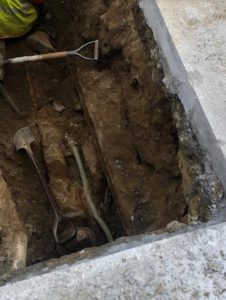A Conversation between Nicolás Dumit Estévez Raful Espejo and Chip Conley

Photo by Marc Olivier LeBlanc
NDERE: Chip, thank you for saying yes to this dialogue and for all of your care during my stay at your Modern Elder Academy (MEA) in Baja California, Mexico. I am happy to name you the Saint of Hospitality and to mention that you share the title with Saint Julian Hospitalier, the patron of hospitality, innkeepers, travelers, and boatmen [sic]. Saint Julian went on to build hospitals where people could sojourn and heal, a place where those in need could find shelter. Can you walk us through the stories of how you became interested in hosting people?
CC: Thank you, Nicolás. I never imagined being a Saint. A Sinner, yet, but a Saint, no. It was an honor to host you in Baja. I’ve always loved making people happy. I guess this is part of the reason I called my boutique hotel company “Joie de Vivre” (joy of life in French) when I started it at age 26. I love that our mission statement (helping people feel joy) was also the name of the company. To me, there’s no greater honor than offering a generosity of spirit from the heart which is my definition of hospitality. In a world that demonizes “the other” and is more robotic with each passing year, I can’t imagine a greater intention than helping us feel the oneness that exists in humanity.
NDERE: I first met you while you were presenting at Wisdom 2.0 in New York, a mindfulness conference, and I heard you talk about elderhood. This is when I said to myself, “I HAVE to study with this man,” since there was a great deal of what you shared that resonated with the work I that have been doing with people 50 and older, mostly in the South Bronx. What was the pull for you to work with people entering this chapter of our lives?
CC: Well, I was one of these people. In early 2013, I was asked by the young Millennial co-founders of Airbnb to help take their fast-growing tech start-up and turn it into a global hospitality giant while also mentoring them. I was 52 and the average age in the company was 26. And, I didn’t know a thing about the tech business. But, the more I studied society’s perspective on aging, I recognized that we’re all likely to live ten years longer than our parents, but power in a digital society is moving ten years younger. So, this has created a twenty-year “irrelevancy gap” that has creeped into our society decades after the term “midlife crisis” was coined. And, it’s part of the reason we see such a disconnect politically in places like the US and UK. Older people get angry when they feel irrelevant.
NDERE: Saint Julian was destined by a curse he received at birth to murder his parents and in the end he was not able to avoid his destiny and perpetrated the parricide/matricide. As result of this, he chose to be of service to others. In your books and in life you talk about your close connection to your father and how this has grown deeper. Unlike Saint Julian, you have been blessed to enjoy life with your father, including surfing together, and to be of service to pilgrims not as a redemptive act, but as way of actively performing love. Can you please tell us more about this?
CC: I learned to surf at age 58, but my father hasn’t. Instead, he learned how to scuba dive at age 60 and has experienced 2,000 dives all over the world since then (he’s now 81) so he recently taught me how to dive and I’ve appreciated this connection later in life because we were very disconnected when I was younger. I think many of us move from hubris to humility over the course of our adult life. That’s been true of my dad as well as me. When you let your ego take a break in the room, it creates more space for connection with others. And, that’s been the story of me and Stephen Sr. (I’m Stephen Jr., a “Chip” off the old block).
NDERE: My mentor and friend of many years, Linda Mary Montano, Saint of Art in Everyday Life, once performed at the Gershwin Hotel in Manhattan MASKS ON/OFF; ON&OFF: A SOMEWHAT INTERACTIVE VIDEO EXPLORATION OF PERSONA IN THE VIDEOS OF LINDA MARY MONTANO. I am bringing this to our conversation because in your book Emotional Equations: Simple Truths for Creating Happiness + Success, you talk about how, for many of us, as we grow older, many of the masks that we wore during previous decades start to come off. Would you be willing to elaborate on the correlation between masks coming off through elderhood and the growth of happiness at this stage of life?
CC: This is a beautiful question. Most people don’t know about the “U-curve of happiness” which shows, across all cultures, that adults see a slow, painful reduction in life satisfaction from ages 25 to 45 years old and between 45 and 50, they start to see a shift such that most of us are happier in our 50s than our 40s and happier in our 60s and 70s than the prior decade. One of the key elements of this shift is learning how to take off our masks and be more comfortable in our own skin (even as it starts to sag!). The primary operating system for the first half of our life is our ego as it helps to individuate us from our parents and define ourselves in society, but American society – in particular – places too much emphasis on our ego and our classic “midlife crisis” is when many of us start shifting from the operating system of the ego to the operating system of the soul. It’s a bit of relief as we stop caring so much about what others think of us and how we fit in.
NDERE: During some of our group discussions at the MEA, the subject of wisdom and elderhood came up. You stated that age does not necessarily confer wisdom on us. Not all older people are wise. I agree with you and I would go on to say that there is a tremendous amount of wisdom that comes from children. Similarly, there can be a significant divide between knowledge and wisdom. I have seen youngsters who, at a very early age, have amassed so much knowledge and I wonder what it would eventually take to transform this into wisdom. Wisdom serves to keep a check on knowledge. You created a wisdom school. What is this place about?
CC: Many of us grew up with the premise of the “three-stage-life.” You study till you’re 20-25. You work till you’re 65. You retire till you die. In a constantly-changing world, the tyranny of the three-stage-life is loosening its grip on us. Life-long learning is essential and it helps us feel more engaged and relevant, but we don’t have “midlife wisdom schools” that support mid-lifers through the variety of transitions that happen between 35 and 75. Society has been effective at creating rites of passage during puberty, adolescence to adulthood, marriage, birth, and death, but, because midlife is a relatively new phenomenon (the average longevity in the US grew from 47 to 77 between 1900 and 2000), we haven’t created rituals and celebrations that help us move from adulthood to elderhood. This is why I created the Modern Elder Academy, a social enterprise on three acres of beachfront land in Baja (Mexico). It helps people reimagine and repurpose their mastery and wisdom for the second half of their adult life. We’re a social enterprise with more than half of our students (average age: 52) being on scholarship as our intent is to be a catalyst for more midlife wisdom schools to sprout around the world.
NDERE: I could go asking you questions. We have not known each other for long, but since I fist saw you on stage at Symphony Space in New York, I fell in love with your path in life. After meeting you at the Modern Elder Academy and studying with you, I confirmed my feelings about your work and how you go about it. With the Modern Elder Academy you are at the forefront of a movement pretty much like those of other people who shook and are shaking the world with love: Elizabeth Kübler-Ross, James Baldwin, Beth Stephen and Annie Sprinkle, and Jane Goodall. The list goes on. Can you talk about love?
CC: Wow, that’s quite a list! The universal theme of all religions and spiritualities is love. It’s also a state of feeling and being that doesn’t discriminate based upon age. I created a website long ago called Fest300 that observed and promoted the 300 best festivals of the year globally. In studying the resurgence of festivals in the 21st century, I was intrigued with the fact that the more digital we get, the more ritual we need. I found that French sociologist Émile Dirkheim, slightly more than 100 years ago when studying religious pilgrimages, coined the term “collective effervescence” to describe the experience of letting your ego evaporate while feeling a simultaneous growth in the sense of communal joy. I think that’s a great way of describing love whether it’s love in a collective or love for one other person. It’s a common feeling we see in our Modern Elder Academy workshop cohorts that last one week each.
NDERE: I saw how you treat people at El Pescadero, the village where the Modern Elder Academy is located. Many there talk about your kindness and your fairness. You have made it your purpose to pay people who work for you well, to care for those who visit, and to be a steward to ecology. You created the Jardín del Alma, the Garden of the Soul, a stark mini nature reserve in a very expensive section of El Pescadero. For those who do not know the area, this has become an extremely desirable destination for wealthy U.S. Americans and Canadians. How are you and the Modern Elder Academy working to be of service to the amazing ecological treasure that is Baja California? I see this as part of what Sally MacFague views as the Body of God.
CC: “I am what survives me.” This is a sentiment expressed by developmental psychologist Erik Erikson. Most of us have no idea what impact we have on others or our communities. This is especially true of capitalists and people in power. I talk in my book Emotional Equations (and to some degree in Wisdom@Work) about the idea of emotional contagion: our behavior and actions influence others. In sum, I feel honored to be able to create the world’s first midlife wisdom school in a fishing and farming community where, hopefully, our actions – whether it’s being a steward of our neighbors or the environment – has a profound influence on others. As Gandhi suggested, “My life is my message.” We’re all role models, whether we know it or not.
NDERE: I thank you, Chip, for your teachings. Unlike in English, in Spanish we have two ways of saying “I love you.” We use these very carefully and discriminately: te quiero and te amo. They imply different levels of commitment, with te amo being reserved for those we really care about. “I love you, te amo, Chip.” This is a hard thing for me to express, and more so publicly, yet your love for people, for those you work with, for those who knock at your door, for our lover Earth, and for life, won me over. “THANK YOU” from the heart. I am extremely grateful that we have crossed elderhood’s path.
© 2019 Chip Conley and Nicolás Dumit Estévez Raful Espejo



